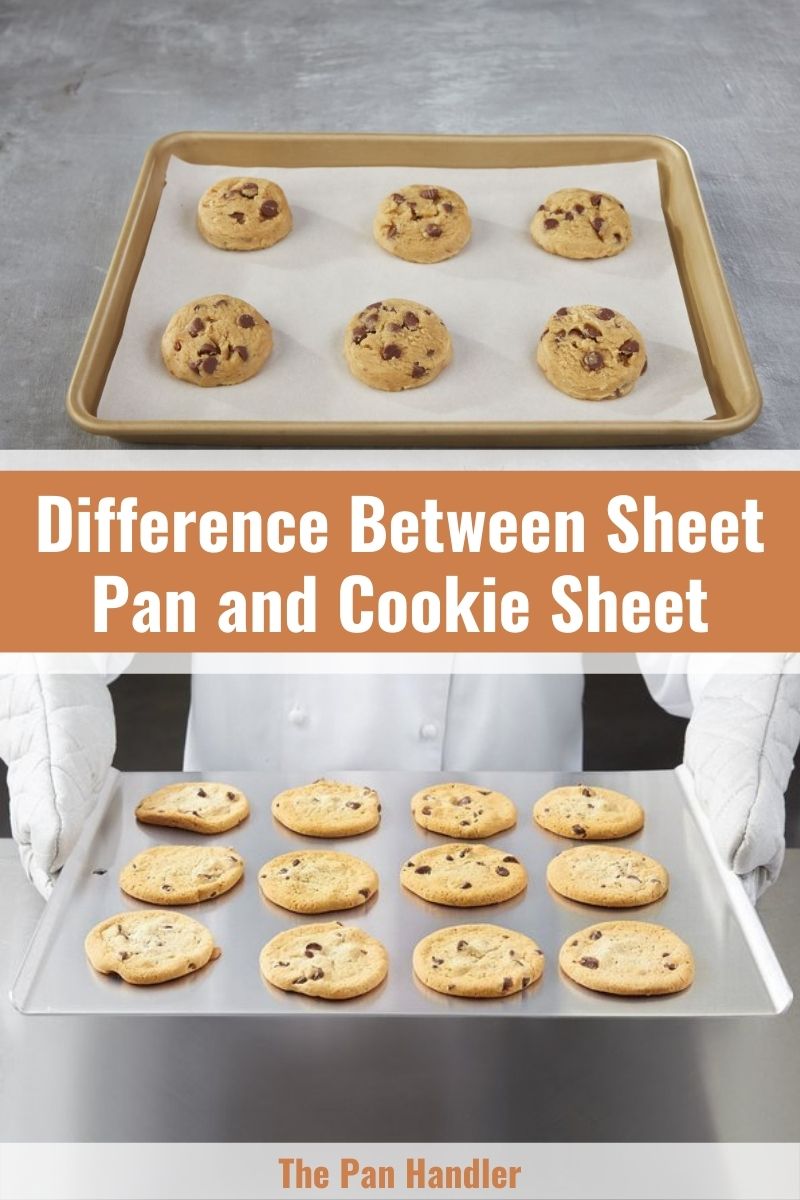Understanding the difference between a sheet pan and a cookie sheet can vastly improve your baking results. Sheet pans, with their raised edges, are versatile kitchen workhorses suitable for everything from roasting vegetables to baking a sheet cake. On the other hand, cookie sheets typically have one open side to allow for easy cookie removal and better airflow, making them ideal for baking cookies that are evenly browned.
Despite their similar appearances, using the correct pan according to its design can affect cooking times and the outcome of your recipes. The right choice can lead to perfect browning and even cooking, while the wrong one might result in unevenly baked goods or spillage in the oven. When shopping for new bakeware, or simply deciding which to use for your next recipe, it’s important to know these distinctions.
What Is a Sheet Pan?

A sheet pan is a versatile bakeware piece characterized by its four raised edges. These edges, usually about an inch high, help contain juices and ingredients, making sheet pans ideal for a range of oven tasks. Sheet pans come in several sizes:
- Quarter sheet pan: Typically 9 by 13 inches
- Half sheet pan: Commonly 18 by 13 inches
- Full sheet pan: Often 26 by 18 inches, mainly used in commercial kitchens
Due to their rimmed edges, sheet pans are perfect for baking items that may release liquids, such as roasted vegetables or meats. They’re also great for baking cookies where you want to prevent sliding.
What Is a Cookie Sheet?
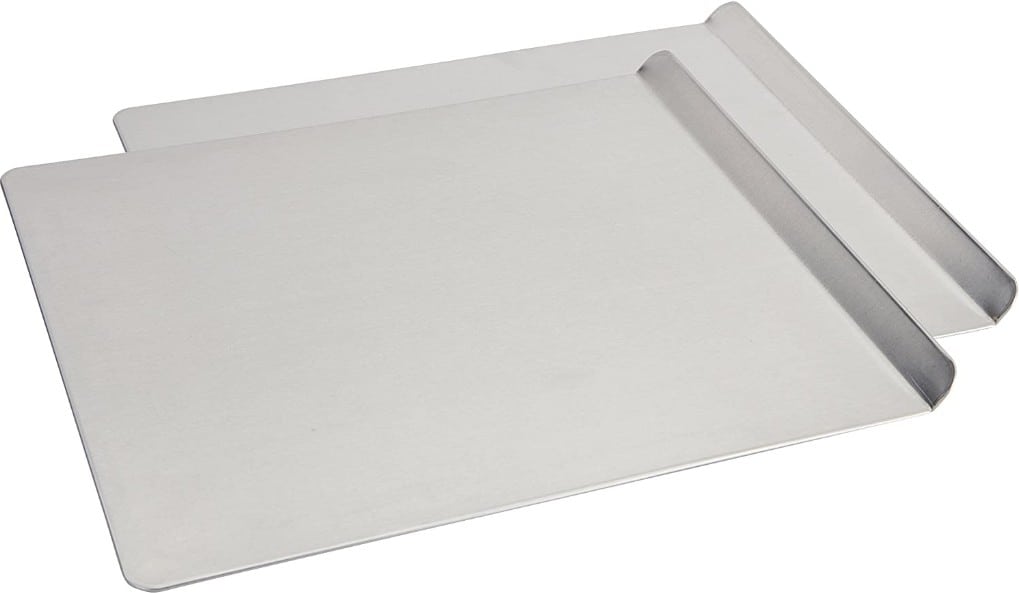
A cookie sheet is designed specifically for baking cookies and similar items. Unlike sheet pans, cookie sheets have one raised edge or sometimes no edges at all, facilitating the easy removal of cookies. Here are some distinctive features:
- Large flat surface: Perfect for spacing out cookies
- One raised edge: This acts as a handle for gripping and moving the pan
- Little to no other edges: Allows for better air circulation around the cookies
Cookie sheets are limited in functionality compared to sheet pans due to their lack of a rim but are highly effective for their intended purpose — baking cookies that are evenly baked and easy to slide off the pan.
Physical Attributes
When exploring the differences between sheet pans and cookie sheets, it’s crucial to understand their distinct physical attributes. These baking tools possess unique sizes, edges, and construction materials that define their specific uses in the kitchen.
Size and Edges
Sheet pans are known for their four raised edges, which often extend about 1 inch high. This design is meant to contain ingredients, making sheet pans ideal for a variety of baked goods and roasted items.
Typically, half sheet pans measure 18 by 13 inches, while the smaller quarter sheet pans come in at 9 by 13 inches. In contrast, cookie sheets generally have one or two raised edges or none at all, facilitating easy sliding of cookies off the pan.
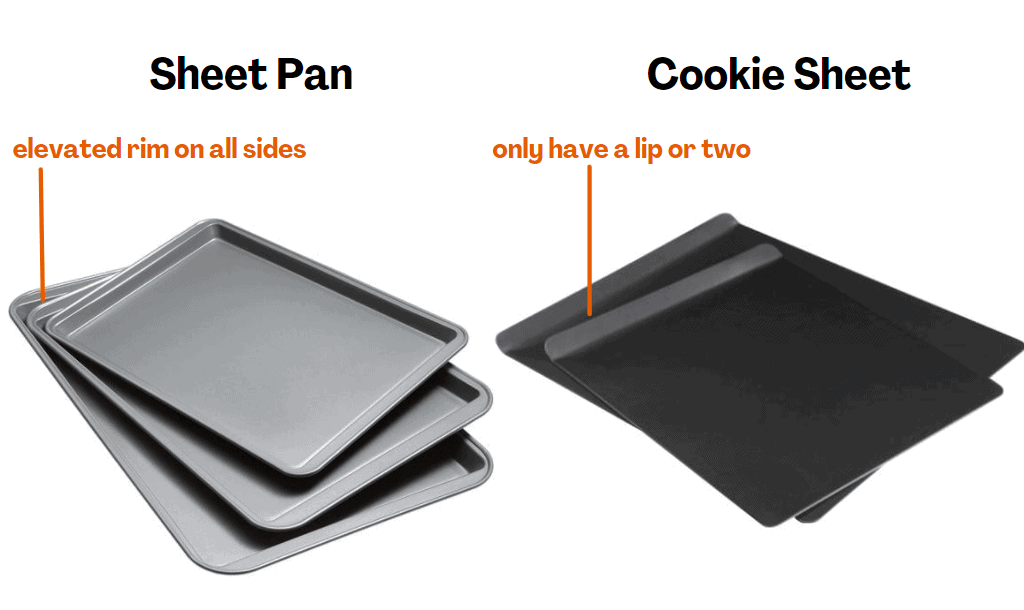
Material and Construction
Both sheet pans and cookie sheets are commonly made from materials such as aluminum or stainless steel; however, their construction can have variations that affect heat distribution and durability. Sheet pans typically feature a sturdy, rimmed design which lends structural support and minimizes warping at high temperatures. Cookie sheets may come with a thin, flat surface that helps to distribute heat quickly, ensuring even browning. Some designs include a layer of air sandwiched between metal sheets to further aid in even baking and reducing hot spots.
Heat Distribution and Airflow
When baking, the way your oven heats your pan can affect the outcome of your baked goods. The type of sheet you use impacts heat distribution and airflow, both crucial for even cooking.
Heat Conductivity
Sheet pans typically have a heavy construction and a rim around the edges, which means they can manage heat distribution effectively. This type of pan retains heat well, leading to a uniform temperature across the baking surface. The material of the sheet pan, often heavy-gauge aluminum, plays a significant role in this aspect. For example, aluminum is an excellent heat conductor, which helps in distributing heat swiftly and evenly across the pan’s surface.
Air Circulation Effects
Cookie sheets are designed to allow better air circulation compared to sheet pans. They usually feature a flat surface, sometimes with only a single raised edge, to enable quicker heating and cooling. This design promotes uniform baking and can prevent overdone edges, especially beneficial for delicate items like cookies. The lack of a rim on a cookie sheet facilitates air flow, enabling heat to reach the entire surface of the cookie more evenly, which can result in a more consistent bake throughout.
Usability and Versatility
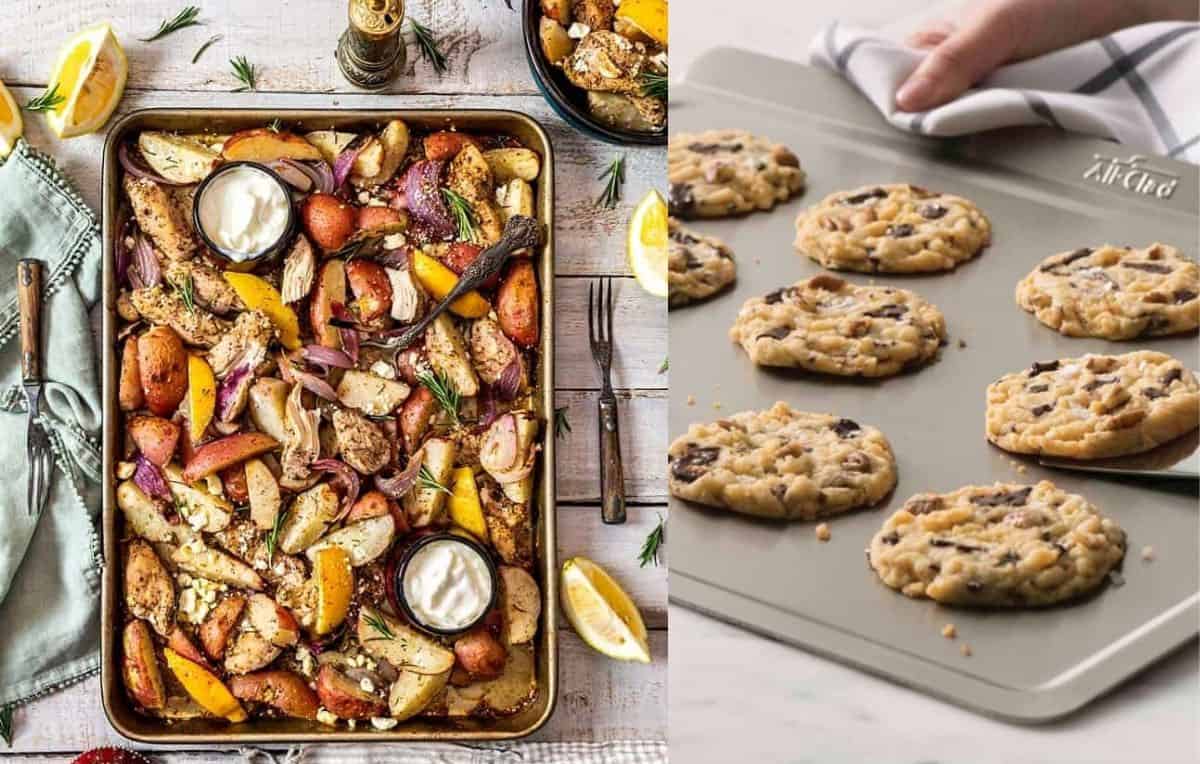
Understanding the differences between sheet pans and cookie sheets will allow you to utilize them effectively in the kitchen and possibly for other uses. The right tool can lead to better cooking results and more versatility in your culinary endeavors.
In the Kitchen
Sheet pans, often preferred for their durability, have a number of uses due to their rimmed edges. These edges are designed to prevent spillage, and they make the pan suitable for a variety of foods beyond cookies, including roasted vegetables, meats, and even sheet cakes. The versatility of a sheet pan makes it an essential item for both home cooks and professional chefs. On the other hand, cookie sheets are typically edgeless, or have a small lip, making them ideal for baking cookies since they allow for easy sliding off of baked goods without the obstruction of a rim.
- Sheet Pans:
- Roasting vegetables and meats
- Baking flat cakes, like sheet cakes
- Cooking foods with liquids or dressings
- Cookie Sheets:
- Baking cookies
- Toasting nuts or seeds evenly
- Reheating pizza for a crisper bottom
Beyond Baking
While these baking tools are standard in a baking environment, their use can extend beyond. You can use sheet pans for organization during food prep; their raised edges keep ingredients contained. Meanwhile, cookie sheets can serve as a surface for crafting projects or as a tray for transporting items that don’t require depth, such as cups or utensils. Their minimalistic design makes them more than just baking accessories.
- Sheet Pans as Organizers:
- Holding prepped ingredients
- Freezing foods flat to prevent clumping
- Cookie Sheets as Utility Trays:
- Serving light snacks during parties
- As a base for rolling out dough to contain messes
Maintenance and Care
Proper maintenance and care are crucial to the longevity of your bakeware. By following the correct cleaning procedures and understanding the factors that contribute to durability, you’ll ensure that your sheet pans and cookie sheets remain functional over time.
Cleaning Procedures
Your sheet pans and cookie sheets require careful cleaning after each use. For aluminum pans, hand wash with warm, soapy water and a soft sponge to prevent damage to the material. Non-stick pans should only be cleaned with non-abrasive cleaners and sponges. To remove stubborn residues, soak the pan in warm water before washing. Dry thoroughly to prevent rust on any steel edges.
- For tough stains or baked-on residue:
- Sprinkle baking soda on the pan’s surface.
- Create a paste with water or vinegar.
- Leave for up to one hour.
- Gently scrub then rinse.
Avoid dishwasher use for non-stick and aluminum pans as it can degrade the coating and cause discoloration.
Longevity and Durability
To maximize durability, store your sheet pans and cookie sheets in a dry environment and stack with care to avoid denting or warping. Aluminum pans can withstand heavy use and high heat, making them a sturdy choice for most baking needs. Non-stick pans, while easier to clean, may show wear more quickly, so use wooden, silicone, or plastic utensils to prevent scratches to the coating.
- Tips for maintaining shape and structure:
- Do not subject pans to extreme temperature changes.
- Avoid using metal utensils that can scratch the surface.
- Handle with care when placing in or removing from the oven.
Choosing the Right Bakeware
When selecting bakeware like sheet pans and cookie sheets, consider the specific recipes and your individual baking preferences to make an informed decision.
Suitability for Recipes
Each type of bakeware serves particular recipes better. Sheet pans are versatile with raised edges that contain food making them ideal for a wide range of baking and roasting tasks from vegetables to meats. With their flat surfaces and little to no edges, cookie sheets provide better heat distribution for quick, even baking, perfect for cookies and other delicate items.
Personal Baking Needs
Think about the frequency and volume of your baking. For larger batches or meals, you’ll benefit from the size of half sheet pans, which are typically 18 by 13 inches. If you’re working in a smaller kitchen or baking smaller quantities, consider quarter sheet pans, usually 9 by 13 inches. Durability and ease of cleaning are also important, so look for heavy-duty materials and non-stick surfaces.
Summary and Final Thoughts
Understanding these differences ensures you select the right tool for your specific baking needs. For further details on how these pans differ and why those differences matter, you can explore the nuances between baking sheets and cookie sheets, which cater to different tasks in the kitchen. Your choice depends on what you’re preparing, but having both in your kitchen arsenal allows for greater flexibility and success in all your baking endeavors.
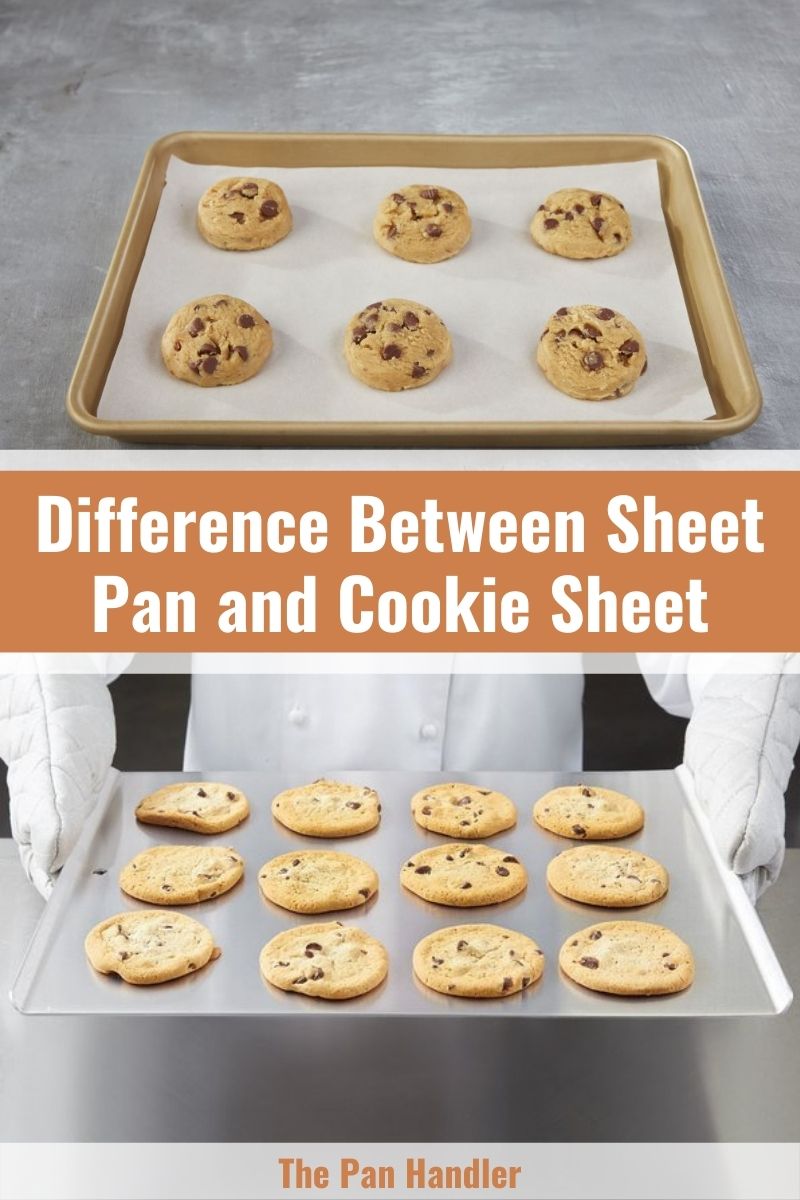

Michael Johnson is the founder of Pan Mastery, Inspired by his blacksmith grandfather’s legacy has a deep appreciation for hand-crafted pots and pans, he provides invaluable guides, reviews, and recipes to enhance your culinary journey.

